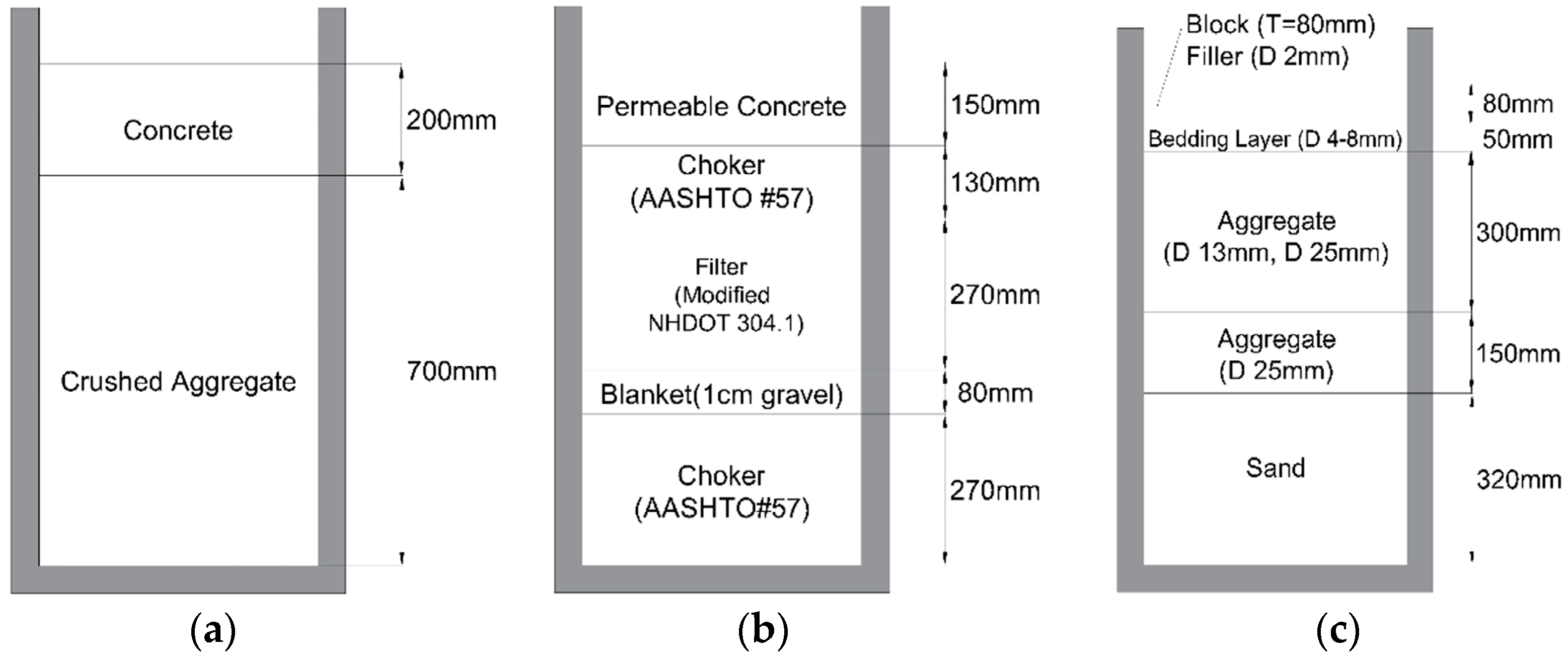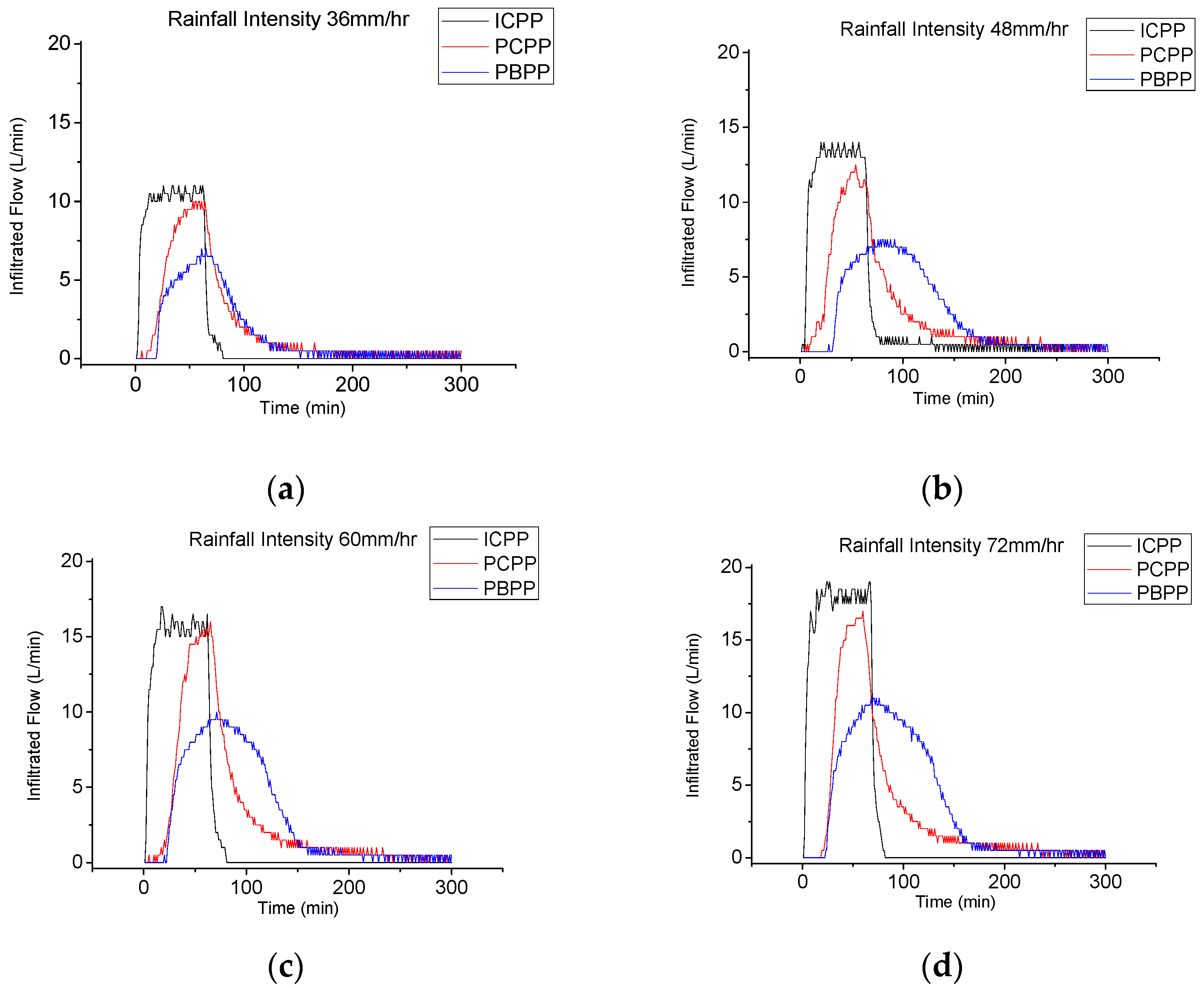Analysis of Infiltrating Water Characteristics of Permeable Pavements in a Parking Lot at Full Scale
Abstract
:1. Introduction
- (1)
- We analyzed the effects on rainwater management and surface flow reduction when permeable pavements were installed in parking lots, which are a significant portion of the impermeable area in urban watersheds.
- (2)
- All of these facilities were full-scaled, same-sized lots consisting of sand, aggregate and a bedding layer for pavements with an infiltrated water monitoring system. The same rainfall scenarios were simulated for impermeable and permeable pavement plots (concrete and block), located in the parking lot LID observation facility of the Korea Green Infra (GI) and Low Impact Development (LID)Centre, Pusan National University, Busan, South Korea. See Figure 1 below for location and coordinates.
2. Materials and Methods
2.1. Parking Lot LID Facility
2.2. Scenario
2.3. Movable Rainfall Simulator
2.4. Monitoring
3. Results
3.1. Flow Characteristics
3.2. Runoff Reduction Ratio
4. Discussion
5. Conclusions
Author Contributions
Funding
Conflicts of Interest
References
- Park, C.Y.; Moon, J.Y.; Cha, E.J.; Yoon, W.T.; Choi, Y.G. Recent Changes in Summer Precipitation Characteristics over South Korea. Korean Geogr. Soc. 2008, 43, 324–336. [Google Scholar]
- Korea Meteorological Administration. Available online: http://www.weather.go.kr/weather/typoon/report.jsp (accessed on 9 June 2020).
- Scalenghe, R.; Marsan, F.A. The anthropogenic sealing of soils in urban areas. Landsc. Urban Plan. 2009, 90, 1–10. [Google Scholar]
- Han, W.S.; KRIHS (Korea Research Institute for Human Settlements, Republic of Korea). Policy Brief; KRIHS: Seoul, Korea, 2011. [Google Scholar]
- Benjamin, B.; Derek, B. Long-term stormwater quantity and quality performance of permeable pavement systems. Water Res. 2003, 37, 4369–4376. [Google Scholar]
- Daniel, J.; Nora, S.; Susanne, C.; Ignacio, A. Coupling GIS with Stormwater Modelling for the Location Prioritization and Hydrological Simulation of Permeable Pavements in Urban Catchments. Water 2016, 8, 451. [Google Scholar]
- ELee, K.; Ahn, J.H.; Shin, H.S. Design Factors and Procedure for Hydrological Design of Permeable Road Systems. J. Korean Soc. Hazard Mitig. 2019, 19, 221–232. [Google Scholar]
- Lin, W.; Ryu, S.; Park, D.G.; Lee, J.; Cho, Y.H. Performeance Evaluation of the Runoff Reduction with Permeable Pavements using the SWMM Model. Int. J. Highw. Eng. 2015, 17, 11–18. [Google Scholar] [CrossRef]
- Andersen, C.T.; Foster, I.D.L.; Pratt, C.J. The role of urban surfaces (permeable pavements) in regulating drainage and evaporation: Development of laboratory simulation experiment. Hydrol. Process. 1999, 13, 597–609. [Google Scholar] [CrossRef]
- Cipolla, S.S.; Maglionico, M.; Stojkov, I. Experimental Infiltration Tests on Existing Permeable Pavement Surfaces. Clean Soil Air Water 2016, 44, 89–95. [Google Scholar] [CrossRef]
- AASHTO. Mechanistic–Empirical Pavement Design Guide: A Manual of Practice; American Association of State Highway and Transportation Officials: Washington, DC, USA, 2015. [Google Scholar]
- AASHTO. Guide for Design of Pavement Structures; American Association of State Highway and Transpor-tation Officials: Washington, DC, USA, 1993. [Google Scholar]
- Baumhardt, R.L.; Romkens, M.J.M.; Whisler, F.D.; Parlange, J.-Y. Modeling infiltration into a sealing soil. Water Resour. Res 1990, 26, 2497–2505. [Google Scholar] [CrossRef]
- Perry, T.; Nawaz, R. An investigation into the extent and impacts of hard surfacing of domestic gardens in an area of Leeds, United Kingdom. Landsc. Urban Plan. 2008, 86, 1–13. [Google Scholar] [CrossRef]
- Conway, T.M. Impervious surface as an indicator of pH and specific conductance in the urbanizing coastal zone of New Jersey, USA. J. Environ. Manag. 2007, 85, 308–316. [Google Scholar] [CrossRef] [PubMed]
- Kim, G.; Yur, J.; Kim, J. Diffuse pollution loading from urban stormwater runoff in Daejeon city, Korea. J. Environ. Manag. 2007, 85, 9–16. [Google Scholar] [CrossRef] [PubMed]
- Bonsu, M. A Physically based model for surface sealing of soil. Eur. J. Soil Sci. 1992, 43, 229–235. [Google Scholar] [CrossRef]
- Assouline, S. Rainfall-induced soil surface sealing: A critical review of observations, conceptual models, and solutions. Vad. Zone J. 2004, 3, 570–591. [Google Scholar] [CrossRef]
- Giakoumakis, S.G.; Tsakiris, G.P. Eliminating the effect of temperature from unsaturated soil hydraulic functions. J. Hydrol. 1991, 129, 109–125. [Google Scholar] [CrossRef]






| Case 1 | Case 2 | Case 3 | Case 4 | |
|---|---|---|---|---|
| Simulating Intensity (mm h−1) | 36 | 48 | 60 | 72 |
| Return Period (year) | 2 | 3 | 5 | 10 |
| Busan (mm h−1) | 43.02 | 51.26 | 60.44 | 72.06 |
| Case | Travel Time(min) | Peak Flow(L/min) | Total Flow(L) | ||||||
|---|---|---|---|---|---|---|---|---|---|
| ICP | PCP | PBP | ICP | PCP | PBP | ICP | PCP | PBP | |
| 1 | 12 | 40 | 48 | 11 | 10 | 7 | 647 | 623.5 | 484.5 |
| 2 | 9 | 40 | 50 | 14 | 12.5 | 7.5 | 803 | 778.5 | 750 |
| 3 | 10 | 44 | 56 | 17 | 16 | 10 | 968.5 | 954.5 | 936 |
| 4 | 8 | 41 | 56 | 19 | 16 | 11 | 1187.5 | 994.5 | 1087.5 |
| Scenario | ICP | PCP | PBP |
|---|---|---|---|
| 1 | 1 | 0.91 | 0.64 |
| 2 | 1 | 0.89 | 0.56 |
| 3 | 1 | 0.94 | 0.59 |
| 4 | 1 | 0.84 | 0.58 |
© 2020 by the authors. Licensee MDPI, Basel, Switzerland. This article is an open access article distributed under the terms and conditions of the Creative Commons Attribution (CC BY) license (http://creativecommons.org/licenses/by/4.0/).
Share and Cite
Park, J.; Park, J.; Cheon, J.; Lee, J.; Shin, H. Analysis of Infiltrating Water Characteristics of Permeable Pavements in a Parking Lot at Full Scale. Water 2020, 12, 2081. https://doi.org/10.3390/w12082081
Park J, Park J, Cheon J, Lee J, Shin H. Analysis of Infiltrating Water Characteristics of Permeable Pavements in a Parking Lot at Full Scale. Water. 2020; 12(8):2081. https://doi.org/10.3390/w12082081
Chicago/Turabian StylePark, Jaerock, Jaehyun Park, Jonghyun Cheon, Jaehyuk Lee, and Hyunsuk Shin. 2020. "Analysis of Infiltrating Water Characteristics of Permeable Pavements in a Parking Lot at Full Scale" Water 12, no. 8: 2081. https://doi.org/10.3390/w12082081
APA StylePark, J., Park, J., Cheon, J., Lee, J., & Shin, H. (2020). Analysis of Infiltrating Water Characteristics of Permeable Pavements in a Parking Lot at Full Scale. Water, 12(8), 2081. https://doi.org/10.3390/w12082081




